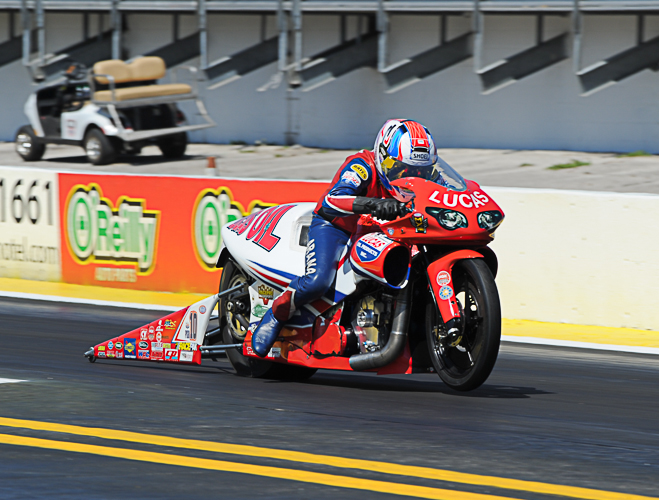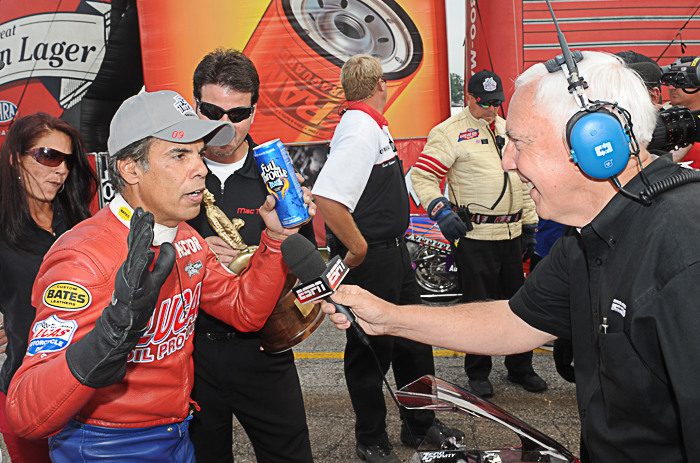HECTOR ARANA SR. - NOT THE MAN YOU THINK HE IS

Hector Arana, Sr.’s Understanding Of What Drag Racing Is And Where It’s Going Extends Far Beyond Two Wheels

Until he tore his rotator cuff while trying to right things after a highway incident, Hector Arana, Sr. was a very competitive and popular rider/team owner in Pro Stock Motorcycle. Since the flat tire and resultant surgery (how embarrassing – injured changing a flat!) Arana has somehow become much more. Chalk it up to the media’s having suddenly discovered that this almost always ebullient individual appears to be even more out-going than he was before. Or maybe it’s something as simplistic as his current inability to work on the team’s Buell motorcycles, leaving him more free time to espouse his views on a wide range of topics, many of them drag racing-related.
Like a top level professional athlete, Arana’s approach to his rehab and eventual return to competition has been thoughtful and, well, professional. Unlike the high school kid who jumps up after being stuffed at the line of scrimmage by an SEC-bound 290 lb. defensive lineman, and assures his coaches and trailers he’s fine, only to discover a full quarter later that his aching leg is indeed broken, Arana has taken the advice of his doctors to heart, and isn’t rushing things. He’s in this for the long haul, not just next weekend’s race.
“It’s hard,” he admits. “It hasn’t been easy. When I missed the Chicago race, that’s when it hit me the most. To watch (the race) on TV, and my son is making runs, and I couldn’t be there just to support him, it was hard on me.” It was the first time in Hector, Jr.’s career that his father hadn’t been there to see him race and offer advice and encouragement. “Since the early 90s, all I’ve known is going to the races,” he added.
Arana skipped the Windy City affair because, “I’m thinking about the long term. I’m thinking that I want to give (my shoulder) a chance to heal so that I can come back strong.” Arana believes that he can yet race this season. “I’ve been injured before,” he says. “You can push it and make a fast recovery, but as the years go by it will haunt you, so the one thing I’ve learned is to take it easy, take it slow.” At 58-years of age Arana may not be feeling the years, but he knows they’re out there and can’t be ignored.

After copping to his 58 years Arana suddenly adds, “I should have lied. I’m only 48!”
“I’m going to play it safe,” the serious tone back in his voice. “If you’re going to (race) you have to be (physically) strong. You’ve got to be able to ‘feel’ that jerk (when the bike launches off the starting line). When you’re hurt, that’s when you realize how much of a G. load you’re putting on your body when you leave (the line). If I feel strong, I’ll give it a shot. If not, I’ll wait until next year (before I try and race again).”
Anyone who thinks drag racing isn’t driven by the sponsors isn’t paying attention, so often, when something like Arana’s injury interrupts things, there’s concern about what the sponsor may expect. But in Lucas Oil Arana has one of the best in terms of truly understanding what drag racing is all about. Lucas Oil is all about drag racing, top to bottom. “That’s what made this transition (to not racing) so much easier,” Arana readily admits. “When I called them up and let them know what was going on, they were terrific. Then they called me back and said that Forest (Lucas) didn’t want anyone else riding the bike, that I shouldn’t worry about anything but healing and getting back out here. When I heard those words it took some weight off my shoulders, so I feel okay about not racing right now.”

When asked if he thinks being an observer to what Hector, Jr. is doing rather than being a fellow racer has changed things, he says, “now I’m looking at things differently. He makes all the (tuning) calls on his bike, so we talk about little things that I maybe see. Then he goes and checks his bike and then goes after what we talked about to see if it’ll work.
“The other thing I’m doing now is I’m trying to be like a coach, talking to him about things like how he rides the bike. I want him to get that edge that he usually has. I just don’t think he has that Eye of the Tiger thing he had going when he first came out (to the races). I think, like a lot of racers, that after a while things become too easy. You have to maintain that edge to win. I’ve been there, so I know what will happen, so I try to talk to him about it.”
Arana has been somewhat surprised by the fan’s reaction to his injury. “So many of them come walking up to say how bad they feel for me, which is very nice. They still want my autograph, too! It feels great that they treat me that way.
“I’ll tell you this. We’re going to keep working hard, and we’re not giving up. We need to win races, and we’re going to.”

A significant number of professional drag racers live in a somewhat insulated world, which doesn’t include Arana. They know far too much about their own category of competition, and far too little about the real business world of drag racing. Arana pays attention, so when he says “I think the bike people do more to help promote drag racing than any other class,” he says so with authority. “Every time a sponsor, or NHRA, asks us to do something to help promote a race, or something like that, we do it right away. We never say no. We want things to be good for everyone involved, so we’re happy to help in any way we can.”
But Arana is also a realist, and knows firsthand how expensive it’s becoming to stay competitive. “We need more (payout) money,” he says. “We haven’t had a raise (in round money) for a very long time, and there’s definitely not enough money to win the championship.” This year the Mello Yello champion will take home $75,000 – the same purse earned 11 years ago. The total payout is $127,100, while in Pro Stock car it’s $399,500. In both fuel categories the total is $799,000. “We’re not Top Fuel,” he says. “We know that, but we still need a chance to make enough money to make it worthwhile.”
Other competitors in Pro Stock Motorcycle suggest that 11 years ago a $300,000 sponsorship was enough to keep a rider in the Top 10, but that’s no longer the case. These same racers now suggest twice that amount is necessary in order to keep with the top teams, with one rider telling a sponsor hunter, “Don’t be afraid to ask for $700,000!” The real problem is balancing a team’s financial needs against the amount of exposure that can be delivered for those sponsors, and here, too, Arana understands what’s needed. “You can only do so much on the track,” he says. “But if you make personal appearances and things like that for your sponsors you can really do some important things. It’s talking to someone who doesn’t know a darn thing about racing that can really make an impression for your sponsors.”
Depending upon when his actual comeback begins, and how things go from there, it might be successfully argued that the best thing to have happened to the 2009 NHRA Full Throttle Champion is a torn rotator cuff and some time off. By standing pitside and trackside as an experienced observer, Hector Arana, Sr. is in a position to deliver the kind of advice and expertise to his team that few others have ever been able to muster. Sometimes a little pain can be a very positive thing.






































